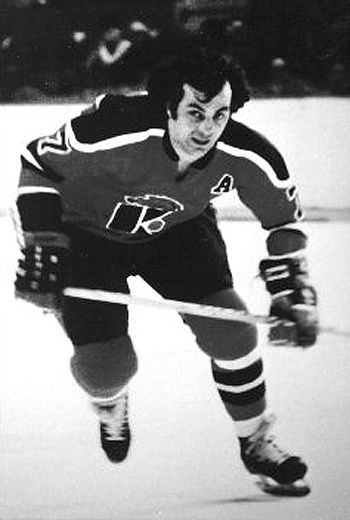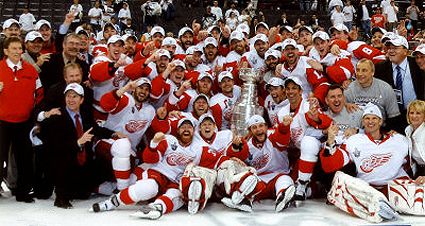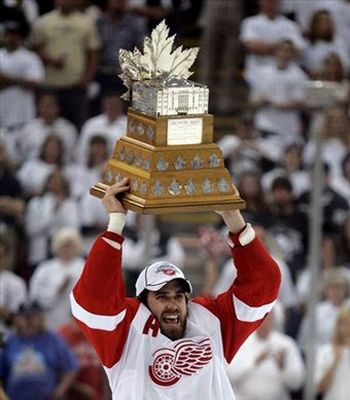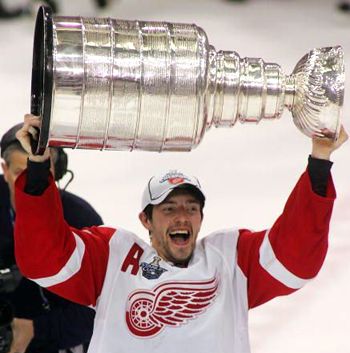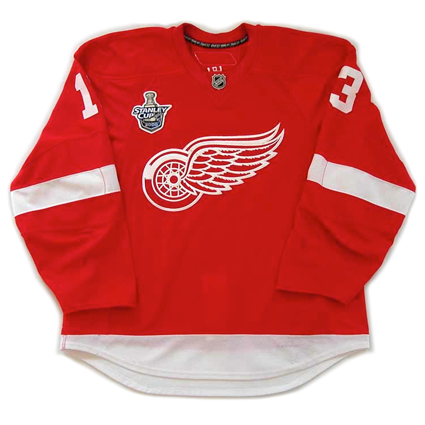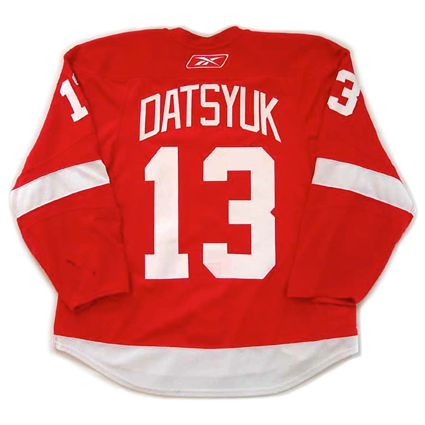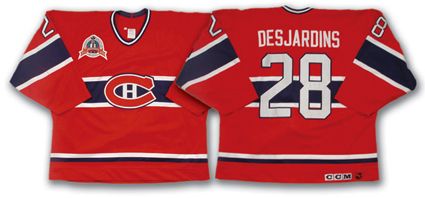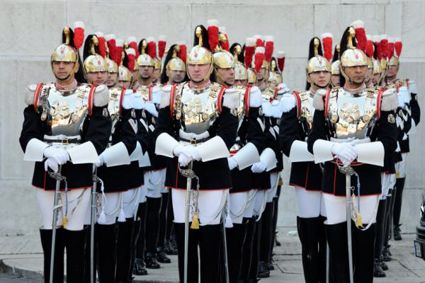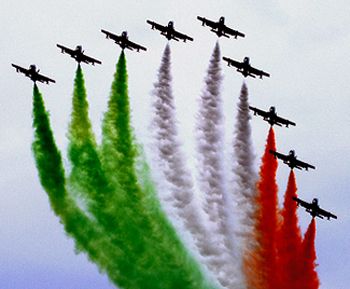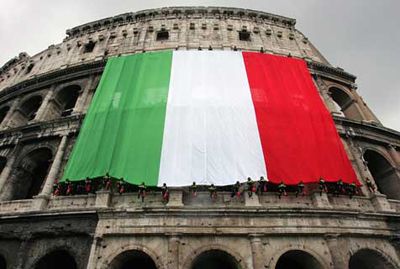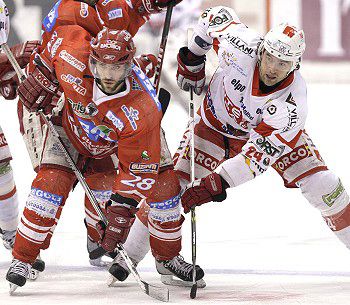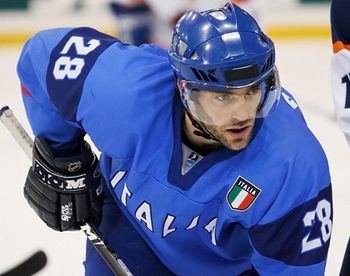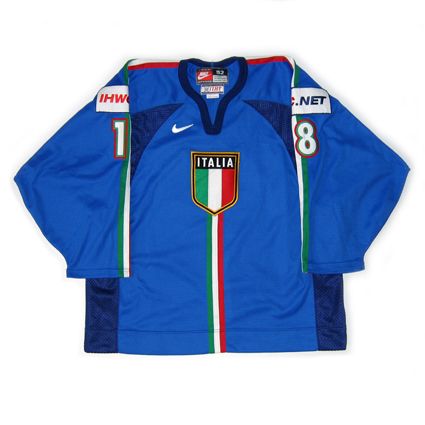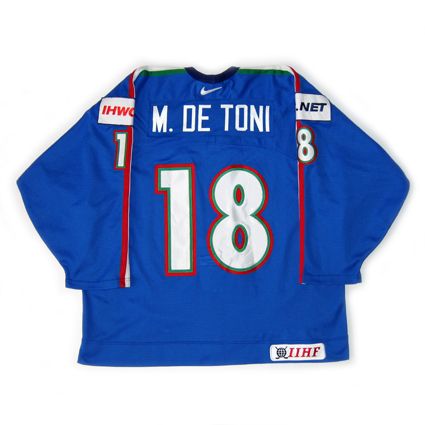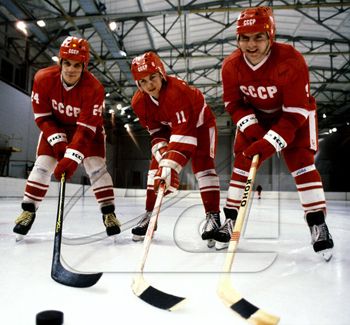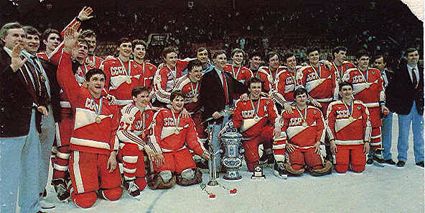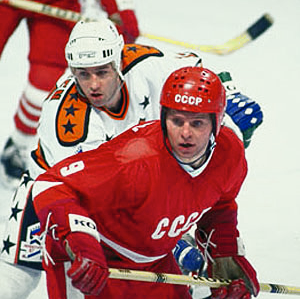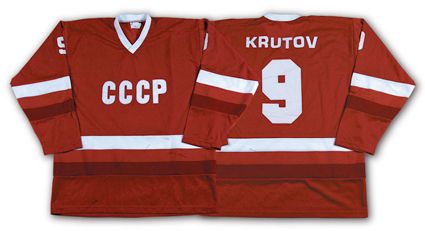Saturday, June 5, 2010
1974-75 San Diego Mariners Andre Lacroix Jersey
Born on this date in 1945, Andre Lacroix, the youngest of 14 children, was a multi-skilled center who played for clubs in both the NHL and WHA during his 13 year professional career.
Lacroix, was clearly a man born at exactly the right time and was able to benefit perhaps more than any other player from the dramatic upheaval in professional hockey during the fifteen year span from 1966 to 1980. While other players were able to benefit better financially, Lacroix was rescued first from the minor leagues when the NHL expanded in 1967 and then liberated from his own personal hockey purgatory with the arrival of the WHA to record one of the greatest offensive careers of his generation.
Lacroix set prolific scoring marks in Canadian junior hockey starting in the 1964-65 season with the Peterborough Petes of the OHA by scoring 119 points in 49 games. He showed his goal scoring ability with 45 tallies and highlighted his remarkable playmaking skills with 74 assists. He was also very adept at winning faceoffs and penalty killing as well. He followed that season with a 120 point campaign in the 1965-66 season to lead the league in points.
Following the Petes regular season, Lacroix played a pair of games with the Quebec Aces of the American Hockey League, scoring 4 points. 1966-67 saw Lacroix adapt to the game at the minor league level with a 25 goal, 24 assist season for 49 points.
He elevated his game to the next level in 1967-68 and was sitting at 41 goals and 87 points in 54 games before being recalled by the expansion Philadelphia Flyers, as this was the season that the NHL expanded from it's traditional six clubs to 12, creating approximately 130 new jobs that never existed before, which Lacroix was more than happy to benefit from. In 18 regular season games with Philadelphia, he scored 6 goals and 14 points, including scoring in his NHL debut against the Pittsburgh Penguins on February 21st, and added 5 more points in 7 playoff games.
Building on the confidence of his successful first season in the league, Lacroix led the Flyers in scoring the next two seasons with 56 and 58 points, respectable totals for a member of one of the new expansion clubs who generally scored 50-75 goals less than the established teams.
After one more season in Philadelphia, Lacroix was traded to the Chicago Black Hawks, which did nothing for Lacroix's game. The Black Hawks were loaded with established offensive talent, the likes of Bobby Hull, Pit Martin, Dennis Hull and Stan Mikita, who all had been playing together on the Original Six club for years. This left very little opportunity for Lacroix to fit in and gain valuable ice time or any confidence, limiting him to only 11 points in 51 games.
Fortune smiled on Lacroix once more, as the following season saw the debut of the World Hockey Association, which was eager to establish itself while in competition with it's established rival, the NHL. The new league was eagerly looking for players with a level of offensive ability, and given the opportunity to return to Philadelphia, Lacroix wasted no time in leaving the bad experience in Chicago behind him and signed with the WHA's Philadelphia Blazers for the 1972-73 season.
Life in the freewheeling, better paying WHA agreed with his game and he immediately set a career best with 50 goals and added 74 assists for 124 points to win the inaugrual league scoring championship.
1972-73 WHA scoring champion Andre Lacroix
While some players were fortunate to find themselves with stable franchises, such as those in Quebec, Winnipeg, Houston, Edmonton and New England (and even they relocated from Boston to Hartford), many more players had to endure the frequent upheavals associated with life in the WHA. Lacroix was forced to live through many of the growing pains, perhaps more than his fair share, and was destined to only play one season in Philadelphia - one way or the other.
The Blazers relocated to Vancouver for the 1973-74 season, but before he could lace up the skates out west, Lacroix was traded to the highly unstable New York Raiders. The franchise was so erratic that they were taken over by the league when the original owners defaulted in year one and sold to a new owner for the second WHA season, who immediately changed the name to the New York Golden Blades. Again, the league ended up taking over the franchise after only 24 games, and moved them out of their money-losing situation as tenants of Madison Square Garden to Cherry Hill, New Jersey for the remainder of the season in a rink so inadequate the visiting teams had to leave the arena in their still wet gear to change into their clothes back at their hotel because of the inadequate situation with the locker rooms there. Worse, the ice surface sloped uphill toward one end!
Rumor has it that the franchise was named the "Knights" because that was the only jersey style a local sporting good store had enough of in stock to be purchased at the last minute following the team's relocation from Manhattan. Ah, life in the WHA.
Lacroix in a seldom seen Knights jersey
Still, throughout all the upheaval and inadequate facilities, Lacroix managed to score 31 goals and lead the league with 80 assists for 111 points, good for second in the league and ahead of the likes of Gordie Howe and Bobby Hull, now in the WHA with Winnipeg.
Clearly the situation in New Jersey was unacceptable and the New York market was now lost to the WHA as the club was sold to a new California-based owner who relocated the team as far from New York as possible to San Diego, California - over 2400 miles away - where they were christened the Mariners.
With the team's situation settled for the time being, Lacroix got back to work and again won the league scoring title, this time with a career high 147 points from 41 goals and a whopping 106 assists, a new professional record at the time and all the more impressive when you consider the Mariners second leading scorer, Wayne Rivers, had 107 total points.
Lacroix again topped 100 points in 1975-76 with 101 and again in 1976-77 with 114 to lead the franchise for the fourth consecutive season. Three seasons of stability was perhaps more than anyone playing in the WHA in the United States was entitled to however, as the Mariners folded after the conclusion of the season.
With his services now available, Lacroix signed with the Houston Aeros as a free agent to replace the scoring of the recently departed Gordie Howe. As was his custom, Lacroix led the Aeros in scoring by a wide margin, with 36 goals and 77 assists for 113 points, 38 more than any other member of the Aeros. But before Lacroix could get truly comfortable, he was on the move once more as the Aeros, one of the strongest and most stable clubs in the WHA up this point, ceased operations when they were left out of any plans to merge with the NHL.
Lacroix signed with the Winnipeg Jets in July of 1978, only to be traded to the New England Whalers in August before even having the chance to report to the Jets training camp! The Whalers were a fairly average team with balanced scoring in 1978-79 and as a result, Lacroix's streak of six consecutive 100 point seasons came to an end with 88 total points that year. Only six other professional players have duplicated Lacroix's 100 points in six consecutive seasons.
In a new twist to the unstable path Lacroix's career had taken, he remained with the Whalers for the 1979-80 season, but the club itself changed leagues, as well as it's name to "Hartford", as the WHA ceased to exist and the Whalers joined the NHL.
Lacroix played in 29 games, scoring 3 goals and 17 points for the Whalers in his final season before retiring.
Lacroix's offensive skills and consistency made him the WHA's all time leader in assists with 547, points with 798 and in games played, totaling 551. Additionally, he ranked fourth in goals scored at 251. All told, Lacroix played in 551 out of a possible 555 games during the seven seasons of the WHA, including not missing a game during the first five seasons of the league.
He was also a member of Team Canada for the 1974 Summit Series against the Soviet Union where he was second on the team with 7 points in 8 games.
Today's featured jersey is a 1974-75 San Diego Mariners Andre Lacroix jersey from his personal best season of 147 points when he led the WHA in scoring for the second time.
During the Mariners three seasons in the WHA, they wore the same style jerseys with no changes aside from a change to contrasting color nameplates in 1975-76.
Today's first video is a profile of Andre Lacroix from his days in the WHA.
Labels:
Andre Lacroix,
San Diego Mariners,
WHA
Friday, June 4, 2010
2007-08 Detroit Red Wings Pavel Datsyuk Jersey
The 2007-08 Detroit Red Wings cruised to the President's Trophy with 115 regular season points from a 54-21-7 record, 7 points ahead of their closest pursuer's, the San Jose Sharks.
Russian Pavel Datsyuk led the team in scoring with 97 points from 31 goals and 66 assists, followed by Swede Henrik Zetterberg's 92 points and team leading 43 goals, the only other player on the team with more than 30 goals.
Next in scoring was defenseman and team captain Nicklas Lidstrom's 70 points. Chris Osgood and Dominik Hasek split the goaltending duties and each won 27 times with Osgood having an edge in Save Percentage and Goals Against Average.
Once the playoff began, the Red Wings first drew the Nashville Predators, who they eliminated in six games. They then faced their past rivals, the Colorado Avalanche. This was no longer the Avalanche team of the late 1990's however, and Detroit was able to advance after a four game sweep.
With the #2 seeded Sharks eliminated in the previous round, the #5 Dallas Stars were the opposition in the Western Conference Finals. Detroit continued their march toward the finals by knocking out Dallas in six games to face the Eastern Conference champion Pittsburgh Penguins.
It was the Red Wings 23rd Stanley Cup Finals and first since 2002. The often critiqued Osgood had taken over in goal from Hasek during the first round of the playoffs and was now the starting goaltender.
Game 1 went to the Red Wings 4-0 behind Osgood's 19 saves versus the 36 shots taken by Detroit. Game 2 was essentially a carbon copy as Osgood made 22 saves for his second consecutive blanking of the Penguins as Detroit won 3-0.
Back in Pittsburgh for Game 3, the Penguins kept their home winning streak intact with a 3-2 win for their 17th consecutive win at The Igloo. Game 4 saw the streak end when Jiri Hudler scored at 2:24 of the third period to break a 1-1 tie to give Detroit a 3-1 lead, putting the Penguins on the brink.
Back in Detroit, the Penguins spoiled the hoped for celebration when Maxime Talbot scored with 34.3 seconds remaining and Marc-Andre Fleury pulled for an extra attacker to force overtime. Veteran Petr Sykora got the game winner for Pittsburgh with Hudler in the penalty box for the Red Wings.
The series then shifted back to Pittsburgh for Game 6 on this date in 2008. Brian Rafalski opened the scoring with a power play goal for Detroit at 5:03 of the first period and Valtteri Filppula made it 2-0 for the visitors at 8:07 of the second.
Evgeni Malkin got Pittsburgh on the board with a power play goal at 15:26, leaving the Penguins down a goal with 20 minutes remaining to stay alive in the series. Detroit's Zetterberg pushed the Detroit advantage back to two goals at 7:36 of the third and Pittsburgh could not solve Osgood until a goal by Marian Hossa on the power play with just 1:27 left in the contest. After a close call in the final seconds, the Red Wings held on to win the game and capture the 11th Stanley Cup title in team history.
For Osgood, it was his second championship as the starting goaltender and his playoff record of 14-4 with a 1.55 goals against average had him under consideration for the Conn Smythe Trophy, which was awarded to Zetterberg, who led all playoff scorers with 27 points (tied with Sidney Crosby) and goals with 13 (tied with teammate Johan Franzen).
Today's featured jersey is a Reebok 2007-08 Detroit Red Wings Pavel Datsyuk jersey. This jersey features the 2008 Stanley Cup Finals patch, worn by Detroit and Pittsburgh. Red Wings jerseys also feature the distinctive radially arched names on the back, used by only Detroit, Colorado and the New York Rangers.
Datsyuk was the fourth leading scorer in the playoffs, and second for Detroit behind Zetterberg, with 10 goals and 13 assists for 23 points in 22 games. After five seasons in the Russian SuperLeague, Datsyuk made the move to North America for the 2001-02 season and joined the Red Wings, who stole him with the 171st pick in the 6th round in 1998. The 2008 Stanley Cup was the second of Datsyuk's career.
The 2007-08 was the first season in which all NHL teams were outfitted with the new Reebok Edge uniform system with it's unique "shirt tail" look, which rethought the entire approach to NHL jersey design and construction to mixed reviews from the players and fans.
Our video selection today are highlights of the 2008 Stanley Cup Finals.
Labels:
Datsyuk,
Detroit Red Wings
Thursday, June 3, 2010
1992-93 Montreal Canadiens Eric Desjardins Jersey
Game 1 of the 1993 Stanley Cup Finals had gone to the visiting Los Angeles Kings by a 4-1 score, making it imperative that the Montreal Canadiens respond with a victory in Game 2 on this date in 1993 before heading to Los Angeles for Games 3 and 4.
Eric Desjardins got Montreal off to a good start by opening the scoring with 1:29 remaining in the first period. Things had not gone Montreal's way however, as they trailed the Kings 2-1 with just 1:45 remaining in the game after a shorthanded goal by the Kings Dave Taylor in the second period and Pat Conacher's goal at 8:32 of the third. Then, with the moment to pull out all the stops having arrived, Montreal coach Jacques Demers called for a measurement of the Kings Marty McSorley's stick.
The officials huddled and the curvature of McSorley's stick was deemed to be outside the allowable limits, necessitating a two-minute minor against Los Angeles.
With McSorley now in the penalty box, leaving the Kings down a man, Demers pulled goaltender Patrick Roy for a 6 on 4 Canadiens advantage. The Canadiens gained control of the puck in the Kings zone and made pass after pass until defenseman Desjardins received the puck out near the blueline in the middle of the zone, where he loaded up and unleashed a slapshot which found the back of the net for his second goal of the night to tie the game with just 1:13 remaining, sending the Montreal faithful into delirium and breaking a 0-for-32 skid on the power play for Montreal.
Then, still in the first minute of overtime, Benoit Brunet broke into the Kings zone and left a drop pass for the trailing Desjardins, who fired wide to the left of the goal. The puck came to Brunet, now behind the Kings goal, who fed it out to Desjardins at the top of the right faceoff circle, as the defenseman had circled back towards the point. Desjardins then took a stride closer to the goal before letting his shot fly, which beat Kelly Hrudey between the pads for the dramatic game winner just 51 seconds into the extra period, lifting the Montreal fans even higher as the Canadiens celebrated on the ice.
Desjardins third goal of the game made him just the first defenseman in 100 years of Stanley Cup history to score a hat trick in the finals.
The Canadiens would put the momentum of their late comeback in Game 2 to good use, winning a pair of overtime games in Los Angeles before coming back to Montreal to clinch the championship with a 4-1 win in Game 5 at home.
It was revealed after the series that the Montreal training staff had snuck into the Kings locker room to secretly measure McSorley's stick in advance of their protest late in Game 2.
In the 19 other playoff games Desjardins played that season, he would score but one other goal, but did contribute 10 assists for 14 total points.
After six seasons with Montreal, Desjardins would be traded to the Philadelphia Flyers and played the remaining 11 years of his career in Philadelphia. He remains the only defenseman to score a ever hat trick in the Stanley Cup Finals.
Today's featured jersey is a CCM 1992-93 Montreal Canadiens Eric Desjardins jersey which features the 1993 Stanley Cup Finals patch, the only time a French version of the Cup Finals patch has been created since it's introduction in 1989.
It was a busy season for the Canadiens seamstresses, as Montreal began the season wearing the 1993 NHL All-Star Game patch. Following the All-Star Game in January, the club wore the Stanley Cup Centennial patch for the remainder of the season and the playoffs, prior to earning the right to wear the Stanley Cup Finals patch as champions of the Wales Conference.
Today's first video is a very well produced look at the Montreal Canadiens run through the playoffs, including the early round highlights.
Dasherboard: The Philadelphia Flyers kept their title hopes alive in Game 3 of the Stanley Cup Finals by the narrowest of margins, as their second goal required a video review to determine that the puck, standing on it's side, had indeed completely crossed the goal line by the slimmest of margins for Scott Hartnell's 5th goal of the playoffs. With that power play goal properly counted, the Flyers were able to take a 2-1 lead before the Blackhawks were able to score on a goal by Brent Sopel late in the second period to send the game into the final 20 minutes even.
Chicago hoped they were on their way to a commanding 3-0 lead when Patrick Kane scored early in the third period for the Blackhawks, only to have the Flyers respond with Ville Leino's goal just 20 seconds later.
The Flyers eventually won the game at 9:59 of the overtime when Claude Giroux scored on a deflection to beat Antti Niemi during a Chicago line change left the Blackhawks short staffed in their defensive zone.
Daniel Briere opened the scoring in the first period for Philadelphia on the power play and Duncan Keith scored at 2:59 of the second for Chicago prior to Hartnell's reviewed goal for Philadelphia. Michael Leighton got the win in goal for the Flyers and was credited with 24 saves while Niemi had 28 saves for Chicago.
Game 4 is in Philadelphia on Friday night.
Labels:
Desjardins Eric,
Montreal Canadiens
Wednesday, June 2, 2010
Festa della Repubblica
Today is Republic Day, or "Festa della Republica" in Italy which commemorates the nationwide vote in 1946 when the Italian population decided which form of government the country would adopt going forward after the fall of Benito Mussolini's Fascist government at the end of World War II.
Given the choice between continuing the monarchy, which had ruled Italy for 85 years and supported Mussolini, which in turn led to Italy's participation in World War II along side the Nazis of Germany, or becoming a republic, a vote was held on this day in 1946 and the Italian people voted 12.7 million (54%) to 10.7 million (46%) in favor of becoming a republic. As a result, the male members of the royal family, the House of Savoy, were exiled from the country, a ban which remained in effect until 2002.
In celebration of the birth of the Italian Republic, each June 2 a military parade along the via dei Fori Imperiali, consisting of the various branches of the Italian armed forces, police and fire departments as well as the Italian Red Cross, is held in Rome and is presided over by the President, with the Prime Minister and other officials also in attendance.
Prior to the parade, a laurel wreath is laid at the Tomb of the Unknown Soldier in Rome's Piazza Venezia while jets fly overhead, leaving plumes of smoke in the colors of the Italian flag.
The parade then proceeds past the presidential viewing box and down the boulevard, which is lined with flag-waving spectators, towards the Colosseum as additional jets fly overhead throughout.
The Italy National Hockey Team made it's international debut in 1924 and first appeared in the World Championships in 1930, with a best result of 4th in 1953. From the 1950's through the early 1990's, Italy generally competed in the "B" Pool if the IIHF ladder system, with occasional drops down to the "C" Pool in the 1970's only to immediately return to the "B" Pool.
In 1991, they earned a promotion back to the Top Division, where they were able to remain for 11 consecutive years, including an excellent 6th place in 1994. It took three years to regain Top Division status in 2005, where they stayed for three years, until beginning their current down, up, down cycle between the Top Division and Division I were they currently find themselves in caught in the struggle to remain in the Top Division but a favorite for promotion while playing in Division I.
Italy's Olympic hockey participation began in 1936 and they have managed to qualify on nine occasions, including a best three in a row in 1992, 1994 and 1998, a particularly strong era of Italian hockey. Historically, the Italian National Team is sprinkled with Canadians of Italian heritage, including former Hartford Whalers goaltender Jason Muzzatti. Of the 23 players on the squad for the 206 Olympics, six were Canadians and two were Americans.
One of the better known Italian hockey players was Gaetano "Gates" Orlando, who was born in Canada and eventually made it to the NHL with the Buffalo Sabres for parts of three seasons prior to continuing his career in the top level of Italian hockey, the Serie A, where he won four championships prior to moving to the Swiss National League A, where he won another pair of titles. Orlando also competed for Italy in 10 World Championships and two Olympic Games.
The Italian Serie A is the top national hockey league of Italy and was founded in 1924 and currently consists of nine teams, concentrated in the far north-east corner of the country with no teams surprisingly in the capital of Rome or other major cities such as Turin, Palermo, Genoa, Milan or Naples.
Today's featured jersey is a 2000 Italy National Team Manuel de Toni jersey which was worn in both the 2000 and 2001 World Championships where Italy competed in the Top Division and finished in 12th place both times.
De Toni, a center, has had a long career in Italian hockey, beginning back in 1994 with HC Alleghe where he still competes today.
Additionally, he has skated for Italy on 16 different occasions, including the European Junior U18 Championships, the World Junior U20 Championships, the World Championships and the Olympics hosted by Italy in 2006.
This jersey is in the familiar blue color as worn by the more familiar "Azzurri" of the Italian National Soccer Team, as blue was the color of the royal House of Savoy, a well established tradition which remains in use today despite the end of the monarchy over 60 years ago.
Today's video segment begins with a look at the military parade that highlights Republic Day in Italy.
Next, some action from Serie A, with HC Alleghe taking on HC Val Pellice followed by a series of player interviews, beginning with De Toni and concluding with goaltender Juliano Pagliero, a Canadian who apparently didn't learn much Italian while growing up in Alberta.
Here's pair of good ones. From the Sabres final game at the Memorial Auditorium, Muzzatti loses his mind and takes on Gary Galley as called by Third String Goalie favorite Rick Jeanneret. Then Muzzatti, then with the Saint John Flames, has a go with the Cornwall Aces Garth Snow while both were in the AHL in the 1994-95 season.
We conclude today with some exciting highlights of the Italy National Team in action.
Labels:
De Toni Marco,
Italy,
Orlando Gates
Tuesday, June 1, 2010
1987 Soviet Union Vladimir Krutov Jersey
Born on this date in 1960, Vladimir Krutov was a member of the famed KLM line, along with Igor Larionov and Sergei Makarov, which dominated Soviet and international hockey the 1980's.
The KLM Line
Krutov, a left winger, played for CSKA Moscow, better known in North America as Central Red Army, beginning with one game in 1977-78 and a half season the following year, in which he scored his first goal before becoming a full time member of the Red Army squad in 1979.
1981-82 would see Krutov set a personal high with 37 goals and 66 points in 46 games and was Red Army's leading scorer with 53 points in 1982-83. CSKA would win the Soviet League championship in each and every of Krutov's 12 season's with the club. Additionally, he led the league in goals in 1984, 1986 and 1987, was named to the USSR All-Star Team every year from 1982 to 1988 and was the Soviet Player of the Year in 1987.
His Soviet League success was duplicated in international play as well, beginning with a pair of gold medals in the World Junior Tournament in 1979 and 1980 while leading the tournament in scoring both years.
Krutov's senior international career began with a silver medal at the 1980 Olympic Games prior to a run of five consecutive gold medals at the 1981 World Championships, the 1981 Canada Cup, the 1982 and 1983 World Championships and the 1984 Olympics.
1984 Olympic Champions
A third place finish in the 1984 Canada Cup and a bronze medal in the 1985 World Championships followed. The Soviet Union would rebound with another gold medal at the 1986 World Championships, where Krutov was named Best Forward, before a pair of silver medals at the 1987 Worlds were Krutov led the tournament in goals and points and was named Best Forward for the second consecutive year, and the 1987 Canada Cup where he was named to the All-Star Team.
The 1988 Olympics concluded with another gold medal after finishing the tournament at the leading scorer and Krutov finished his international career in style with his fifth World Championship gold in 1989.
Krutov finished with 150 goals in 254 international games and his medal count shows ten gold medals, three silver and two bronze, which included at least one gold at each of the World Juniors (2), World Championships (5), the Canada Cup (1) and the Olympics (2).
He was one of the first wave of Soviet players allowed to join the NHL, playing for the Vancouver Canucks in 1989-90, where he played for just one season, scoring 11 goals and 34 points in 61 games while he tried to adjust to life and the sudden freedom he was afforded in North America after an entire career in which he was required to train 10 months out of the year. It was unfortunate that Krutov's attempt to play in the NHL was viewed as unsuccessful after such a stellar career in the Soviet Union since it tainted many North American's opinion of Krutov based on just a single season late in his career.
Krutov played very little hockey in 1990-91, just one regular season game and three playoff games with the ZSC Lions in Switzerland. After another season with ZSC, he moved to Ostersund IK in the lower levels of the Swedish hockey leagues for three seasons and wrapped up his career with Brunflo IK before retiring.
He was named to the Soviet Hockey Hall of Fame in 1981 and the International Ice Hockey Federation Hall of Fame in 2010.
Today's featured jersey is a 1987 Soviet Union National Team Vladimir Krutov jersey as worn by Krutov during Rendez-vous '87, a two-game series held in Quebec City on February 11 and 13, 1987 which replaced that season's NHL All-Star Game which featured a team of NHL All-Stars against the Soviet National Team.
Game 1 went to the NHL All-Stars 4-3 and the Soviets came back to win Game 2 5-3 in which Krutov scored a pair of goals, including the game winner at 9:19 of the third period.
This jersey is typical of the Soviet style, with a minimum of adornments and simple one color names and numbers, made to look even more spartan when compared to the flashy NHL All-Star jerseys it competed against.
photo courtesy of Classic Auctions
Today's video section begins with Krutov scoring against the Montreal Canadiens on December 31, 1982 in an exhibition game.
Here Krutov scores for the Soviets in Rendez-vous '87 to put the Soviets ahead 2-0 followed by his game winning goal to make it 4-2 on the Soviets way to a 5-3 win.
In some truly rare footage, Krutov scores on a penalty shot for the ZSC Lions, quite possibly the slowest approach in the history of hockey.
Labels:
Krutov Vladimir,
Soviet Union
Subscribe to:
Comments (Atom)



